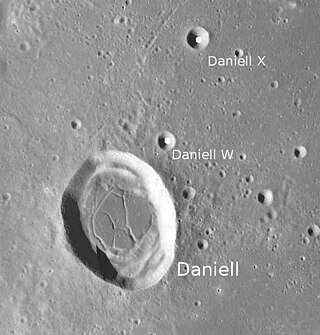
Daniell is a lunar impact crater located in the southern half of the Lacus Somniorum. To the south-southeast is the much larger crater Posidonius. The Rimae Daniell rille system are to the west of Daniell crater.

Brackett is a small lunar impact crater that lies near the southeast edge of Mare Serenitatis. The crater is named after American physicist Frederick Sumner Brackett. The crater has been covered by lava flow, leaving only a ring-shaped trace in the surrounding lunar mare. This crater is best observed under oblique illumination, as it is otherwise difficult to find. The southern rim is almost contacting a rille system named the Rimae Plinius.

Posidonius is a lunar impact crater that is located on the north-eastern edge of Mare Serenitatis, to the south of Lacus Somniorum. It was named after ancient Greek philosopher and geographer Posidonius of Apamea. The crater Chacornac is attached to the southeast rim, and to the north is Daniell.

Ramsden is a lunar impact crater located on the western stretch of the Palus Epidemiarum. It was named after British instrument maker Jesse Ramsden. To the east-southeast is the crater Capuanus, and to the north lies Dunthorne.
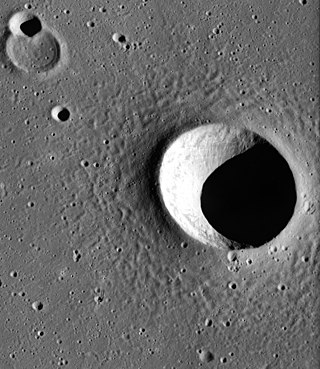
Wollaston is a relatively small lunar impact crater located in the Oceanus Procellarum. To the northwest is the similar Nielsen. To the southeast is the somewhat larger Krieger. There are several small rilles to the southwest of Wollaston, forming part of the Rimae Prinz.

Väisälä is a tiny lunar impact crater located on a rise in the Oceanus Procellarum. Sharing the same continental island are the brilliant crater Aristarchus to the south-southeast and Herodotus to the south-southwest. Väisälä lies just to the west of the Rupes Toscanelli fault line, and the Rimae Aristarchus rille system. To the southwest is the notable Vallis Schröteri cleft.

Ariadaeus is a small, bowl-shaped lunar impact crater on the western shores of Mare Tranquillitatis. It lies to the north of the crater Dionysius, and to the west-southwest of Arago. The crater is joined along the northeast rim by the slightly smaller Ariadaeus A, and the two form a double-crater. Its diameter is 10.4 km.

Cavendish is a lunar impact crater that is located in the southwest part of the Moon, to the southwest of the larger crater Mersenius. It lies between the smaller craters Henry to the west-northwest and de Gasparis to the east-southeast.

Goclenius is a lunar impact crater that is located near the west edge of Mare Fecunditatis. It lies to the southeast of the lava-flooded crater Gutenberg, and north of Magelhaens. To the northwest is a parallel rille system that follow a course toward the northwest, running for a length of up to 240 kilometers. This feature is named the Rimae Goclenius.

Hippalus is the remnant of a lunar impact crater on the eastern edge of Mare Humorum. It was named after ancient Greek explorer Hippalus. To the southeast is the crater Campanus, and to the northwest is the small flooded crater Loewy.

Mercator is a lunar impact crater that is located on the southwestern edge of Mare Nubium, in the southwest part of the Moon. It was named after 16th-century Southern Dutch cartographer Gerardus Mercator. It is located to the southeast of the crater Campanus, and the two are separated by a narrow, winding valley.

Prinz is the lava-flooded remains of a lunar impact crater on the Oceanus Procellarum. It was named after German-Belgian astronomer Wilhelm Prinz. The formation lies to the southwest of the prominent crater Aristarchus. To the north-northeast is the flooded crater Krieger.

De Vico is a small lunar impact crater that is located in the southwest part of the Moon, to the south of the crater Sirsalis. To the west-northwest is Crüger. De Vico is a circular, bowl-shaped formation with a small, flat bottom at the midpoint. To the northwest is the lava-flooded remains of De Vico T. Beyond is a linear rille designated Rimae Sirsalis that follows a path to the northeast past the rim of Sirsalis.
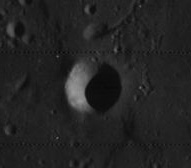
Toscanelli is a tiny, bowl-shaped lunar impact crater that is located to the north of the prominent crater Aristarchus, in the northwestern part of the Moon. The crater lies at the southern end of a rille that proceeds towards the north. This rille is part of a nearby system that has the designation Rimae Aristarchus. Just to the south of Toscanelli is a fault line in the surface named the Rupes Toscanelli, after the crater. This break in the surface continues to the south for a distance of about 70 kilometers.
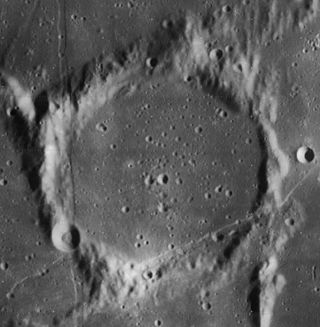
Parry is a lunar impact crater that is attached to the southeast rim of the walled plain Fra Mauro. It was named after British explorer William Parry. Attached to the west and southwest rim of Parry is the crater Bonpland. Due south of Parry is the small crater Tolansky, and farther to the south-southwest is Guericke.

Campanus is a lunar impact crater that is located on the southwestern edge of Mare Nubium. It was named after Italian astronomer Campanus of Novara. It forms a crater pair with Mercator just to the southeast. Along the southern rampart of Campanus is the small lunar mare named Palus Epidemiarum. To the southwest is the small crater Dunthorne.
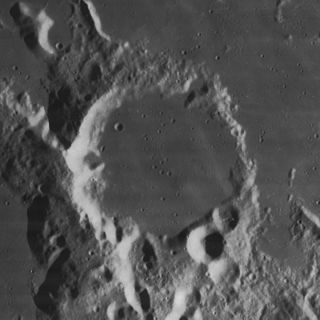
Capuanus is a lunar impact crater that lies along the southern edge of the Palus Epidemiarum. It was named after Italian astronomer F. Capuano di Manfredonia. The outer rim is eroded and indented by lesser crater impacts, with notches in the north, west, and southern parts of the rim. The interior floor has been resurfaced by basaltic lava, which is connected to the surrounding lunar mare by a narrow, crater-formed gap in the northern rim. Dotting the floor of the crater are a number of domes, which are believed to have formed through volcanic activity.

Maclear is a lava-flooded crater on the northwest part of the Mare Tranquillitatis, a lunar mare in the eastern half of the Moon. Its diameter is 20 km. The crater is located to the southwest of the slightly larger Ross. To the southwest of Maclear is Sosigenes, while farther to the south-southeast is Arago.
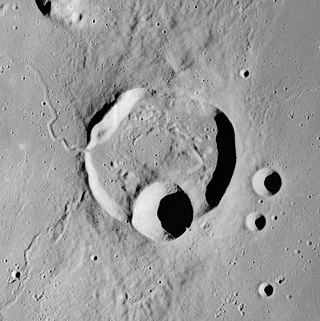
Van Biesbroeck is a small lunar impact crater that interrupts the southern rim of the lava-flooded crater Krieger, in the Oceanus Procellarum. The crater is circular and symmetrical, with sloping inner walls that run down to a small interior floor. Van Biesbroeck was designated Krieger B before the IAU gave it a unique name in 1976.
Fontana is a lunar impact crater that is located in the southwestern part of the Moon's near side, to the south of the Oceanus Procellarum. It lies to the west-northwest of the flooded crater Zupus. Midway between Fontana and Zupus is a rille system designated Rimae Zupus.





















